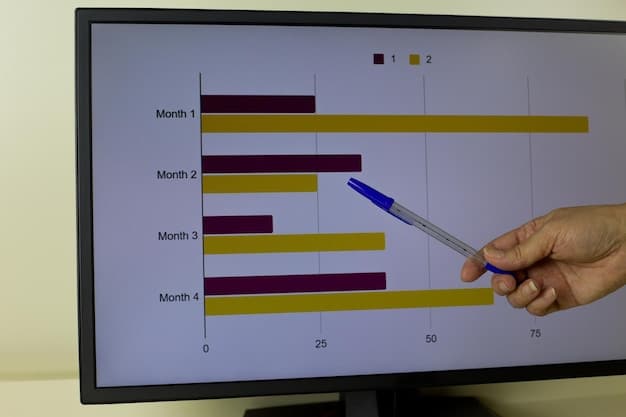E-commerce Email Marketing: Boost Open Rates by 15% Next Quarter

E-commerce email marketing can significantly increase open rates by 15% in the next quarter by implementing strategies focused on subject line optimization, personalization, segmentation, timing, and deliverability improvements, ensuring emails reach the intended audience effectively.
Want to see a 15% jump in your e-commerce email open rates in the next quarter? It’s achievable. This article dives into actionable strategies for E-commerce Email Marketing: How to Increase Open Rates by 15% in the Next Quarter, designed to capture attention and drive engagement.
Crafting Compelling Subject Lines
Subject lines are the gatekeepers to your emails, and crucial for E-commerce Email Marketing: How to Increase Open Rates by 15% in the Next Quarter. If they don’t entice, your emails remain unopened, no matter how valuable the content inside. Creating subject lines that resonate with your audience and pique their curiosity is essential to improving your email marketing performance.
Personalize Your Subject Lines
Personalization can make a huge difference. Use the recipient’s name, location, or even past purchase history to create a more relevant and engaging subject line.
Create a Sense of Urgency
Urgency can motivate recipients to open your email immediately. Use words like “Limited Time Offer,” “Act Now,” or “Last Chance” to create a sense of scarcity.
- 🤔 **Use Numbers:** Numbers in subject lines often grab attention. For instance, “50% Off Today Only!”
- ✨ **Ask a Question:** A well-crafted question can intrigue readers and make them want to find the answer inside the email.
- ✅ **Keep it Short and Sweet:** Mobile users often see only the first few words of a subject line, so make them count. Aim for under 50 characters.
Mastering the art of writing captivating subject lines is a continuous process of testing and refinement. By implementing these strategies and analyzing the results, you can significantly increase your email open rates.
Segmenting Your Email List for Targeted Content
Segmentation is the process of dividing your email list into smaller, more targeted groups based on shared characteristics. When it comes to E-commerce Email Marketing: How to Increase Open Rates by 15% in the Next Quarter, segmenting ensures that the right message reaches the right recipient, boosting relevance and engagement.
Demographic Segmentation
Segment your list based on demographics such as age, gender, location, and income level. This allows you to tailor your messaging to specific groups.
Purchase History Segmentation
Segment based on past purchases to send targeted product recommendations, restock reminders, or special offers related to their previous buys.

- 📊 **Engagement Segmentation:** Identify your most active subscribers and those who haven’t engaged in a while. Re-engage inactive users with special promotions or personalized content.
- 📧 **Behavioral Segmentation:** Track how subscribers interact with your website and emails. Send targeted messages based on their browsing behavior or specific actions they take.
- 🎁 **Lifecycle Segmentation:** Target welcome emails for new subscribers and special promotions for long-term customers.
Segmenting your email list allows you to send highly targeted and relevant content, which improves engagement, reduces unsubscribe rates, and ultimately increases your email open rates.
Personalizing Email Content for Maximum Impact
Personalization goes beyond just using the recipient’s name. It’s about creating email content that truly resonates with each individual subscriber. For E-commerce Email Marketing: How to Increase Open Rates by 15% in the Next Quarter, personalization is the best tool to make emails feel less like generic broadcasts and more like tailored conversations.
Use Dynamic Content
Dynamic content changes based on the recipient’s data, such as their location, purchase history, or preferences. This ensures that each subscriber sees content that is relevant to them.
Product Recommendations Based on Past Purchases
Recommend products that are similar to or complement their previous purchases. This shows that you understand their needs and interests.
- 🎉 **Personalized Offers:** Send special discounts or promotions based on their purchase history or loyalty status.
- 📝 **Birthday and Anniversary Emails:** Acknowledge special occasions with a personalized message and an exclusive offer.
- 🚀 **Behavior-Based Personalization:** Trigger emails based on specific actions a subscriber takes on your website, such as abandoning a cart or viewing a particular product.
By meticulously personalizing email content, you’re not just sending emails; you’re building relationships and trust with your subscribers. This leads to higher open rates, increased engagement, and ultimately, more conversions.
Optimizing Email Send Times for Higher Visibility
Timing is everything. Sending your emails when your subscribers are most likely to be checking their inboxes can significantly improve your open rates. For E-commerce Email Marketing: How to Increase Open Rates by 15% in the Next Quarter, understanding your audience’s habits and preferences is key to optimizing send times.
Analyze Past Campaign Data
Look at your past email campaigns to identify the days and times that have resulted in the highest open rates.
Consider Your Target Audience’s Time Zone
If you have subscribers in multiple time zones, segment your list and send emails at the optimal time for each time zone.

- ⏰ **Test Different Send Times:** Experiment with sending emails at different times to see what works best for your audience.
- 📅 **Consider Weekday vs. Weekend:** Weekday emails may be more effective for B2B audiences, while weekend emails may be better for consumers.
- 💡 **Use Predictive Sending:** Some email marketing platforms offer predictive sending features that use machine learning to determine the best time to send emails to each individual subscriber.
Optimizing email send times is an ongoing process that requires careful analysis and testing. By understanding your audience’s habits and preferences, you can significantly improve your email open rates.
Improving Email Deliverability to Reach the Inbox
Deliverability is about ensuring that your emails actually reach your subscribers’ inboxes rather than ending up in the spam folder. When aiming for E-commerce Email Marketing: How to Increase Open Rates by 15% in the Next Quarter, improved deliverability is essential, because unread emails have zero impact.
Authenticate Your Emails
Set up SPF, DKIM, and DMARC records to verify that your emails are legitimately sent from your domain. This helps prevent email spoofing and phishing.
Maintain a Clean Email List
Regularly remove inactive subscribers and bounced email addresses from your list to maintain a high sender reputation.
- 🛡️ **Monitor Your Sender Reputation:** Use tools like Sender Score and Google Postmaster Tools to monitor your sender reputation and identify any issues that may be affecting deliverability.
- ✉️ **Avoid Spam Trigger Words:** Be mindful of the words and phrases that can trigger spam filters, such as “free,” “guarantee,” and “limited time offer.”
- ✅ **Encourage Subscribers to Whitelist Your Emails:** Ask subscribers to add your email address to their address book or whitelist to ensure that your emails are delivered to their inbox.
By taking steps to improve your email deliverability, you can ensure that your emails reach the intended audience and increase your open rates.
A/B Testing Email Elements for Optimal Performance
A/B testing, also known as split testing, is a crucial strategy to determine which elements of your email campaigns resonate most with your audience. Implementing A/B testing in your E-commerce Email Marketing: How to Increase Open Rates by 15% in the Next Quarter plan allows data-driven decisions rather than relying solely on hunches.
Test Different Subject Lines
Evaluate which subject lines generate better open rates. Experiment with length, tone, emojis, and calls to action.
Experiment with Different Send Times
Test sending emails at various times of the day to identify peak engagement periods for your audience.
- 🎨 **Test Different Email Designs:** Examine the impact of different layouts, colors, and image placements on your click-through rates.
- 📝 **Test Different Calls to Action:** Try out varied phrasing, button designs, and placement of calls to action to see what drives the most conversions.
- ✨ **Test Different Personalization Strategies:** Determine whether personalizing subject lines or email content leads to higher engagement.
A/B testing provides empirical data that informs your strategy. By continuously testing and refining your email campaigns, you can significantly improve your engagement metrics and overall ROI.
| Key Element | Brief Description |
|---|---|
| 🔑 Subject Lines | Entice recipients with compelling, personalized subject lines. |
| 📧 Segmentation | Target specific groups with tailored content. |
| ⏰ Send Times | Optimize timing for maximum visibility. |
| 📊 A/B Testing | Continuously refine based on performance data. |
Frequently Asked Questions (FAQ)
▼
Email marketing is crucial for e-commerce because it allows businesses to directly engage with customers, promote products, and build relationships. It’s a cost-effective way to drive sales and increase customer loyalty.
▼
The ideal frequency depends on your audience and industry. A good starting point is 1-3 emails per week, but monitor engagement and adjust based on subscriber behavior to avoid overwhelming them.
▼
Common mistakes include not segmenting your list, sending irrelevant content, using spam trigger words, ignoring mobile optimization, and failing to track and analyze your results. Avoiding these pitfalls can significantly improve your email marketing performance.
▼
Track metrics such as open rates, click-through rates, conversion rates, unsubscribe rates, and ROI. These metrics provide valuable insights into the effectiveness of your campaigns and help you optimize for better results.
▼
Popular tools include Mailchimp, Sendinblue, HubSpot Email Marketing, and ActiveCampaign. Each offers different features and pricing plans, so choose the one that best fits your needs and budget.
Conclusion
Achieving a 15% increase in e-commerce email open rates within the next quarter is a realistic goal with the right strategies. By focusing on compelling subject lines, segmentation, personalization, optimized send times, improved deliverability, and consistent A/B testing, you can significantly enhance your email marketing performance and drive more engagement and sales.





